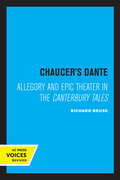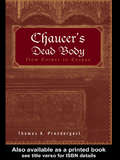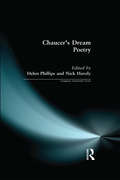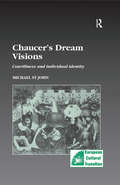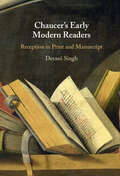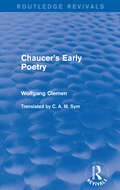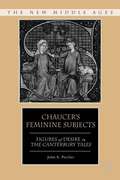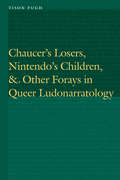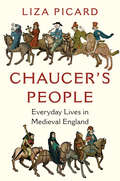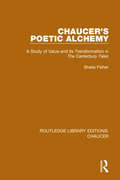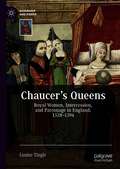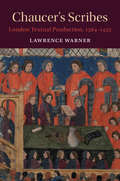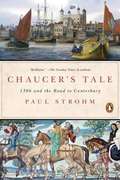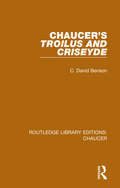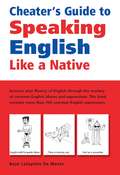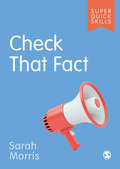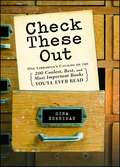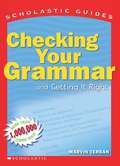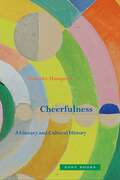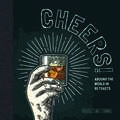- Table View
- List View
Chaucer's Dante: Allegory and Epic Theater in the Canterbury Tales
by Richard NeuseRichard Neuse here explores the relationship between two great medieval epics, Dante's Divine Comedy and Chaucer's Canterbury Tales. He argues that Dante's attraction for Chaucer lay not so much in the spiritual dimension of the Divine Comedy as in the human. Borrowing Bertolt Brecht's phrase "epic theater," Neuse underscores the interest of both poets in presenting, as on a stage, flesh and blood characters in which readers would recognize the authors as well as themselves. As spiritual autobiography, both poems challenge the traditional medieval mode of allegory, with its tendency to separate body and soul, matter and spirit. Thus Neuse demonstrates that Chaucer and Dante embody a humanism not generally attributed to the fourteenth century. This title is part of UC Press's Voices Revived program, which commemorates University of California Press’s mission to seek out and cultivate the brightest minds and give them voice, reach, and impact. Drawing on a backlist dating to 1893, Voices Revived makes high-quality, peer-reviewed scholarship accessible once again using print-on-demand technology. This title was originally published in 1991.
Chaucer's Dead Body: From Corpse to Corpus
by Thomas A. PrendergastFirst published in 2004. Routledge is an imprint of Taylor & Francis, an informa company.
Chaucer's Dream Poetry (Longman Annotated Texts)
by Helen Phillips Nick HavelyDream literature is regarded as one of the most important genres in medieval literature and is widely studied. This text provides a succinct and clear introduction to the five central poems that comprise Chaucer's Dream Poetry, and shows his role as a leading adapter of European Literary tradition into English Literature. The poems discussed are The Book of the Duchess, The Legend of Good Women, The Legend of Dido, The Parliament of Fowls and The House of Fame. Each have an introduction setting the poem within the context of Dream Poetry and Chaucer's own work. Appendices of proper names, pronunciation and criticism are also given. This volume is unique is presenting the poems together in an editorial and critical framework. The quality of annotation is unrivalled and will make this text a major addition to the literature suitable for those interested in the genre, literary, or more general history of the period.
Chaucer’s Dream Visions: Courtliness and Individual Identity (Studies in European Cultural Transition #7)
by Michael St JohnChaucer used the dream device to engage with the work of French and Italian authors and to explore the philosophical content of their poetry. His four dream visions therefore represent an important conduit through which the influence of European writers was received into English, enabling a profound transition in the way in which the 'self' was conceptualized in medieval courtly literature. Chaucer's Dream Visions is the first book length study to examine the poet's considered use of Aristotelian psychology to describe the mind of the courtly subject in its social context. The study shows that by drawing upon Aristotelian psychology, derived from his reading of Boethius, Dante, and the poets of the French court, Chaucer was able to articulate precisely those aspects of the courtly identity that are determined by language and empirical experience, and those which are transcendent of this determinism. A detailed engagement with the literature, language, and behaviour of the court therefore takes place in the dream visions, which are a genuine exploration of individual subjectivity in its social context. The author of this volume demonstrates that the motivation for this exploration is a product of Chaucer's Christian beliefs and philosophical awareness. Chaucer's Dream Visions thus constitutes a major contribution to the debate concerning distinctions between medieval and early modern culture.
Chaucer's Early Modern Readers: Reception in Print and Manuscript
by Devani SinghThe first extended study of the reception of Chaucer's medieval manuscripts in the early modern period, this book focuses chiefly on fifteenth-century manuscripts and discusses how these volumes were read, used, valued, and transformed in an age of the poet's prominence in print. Each chapter argues that patterns in the material interventions made by readers in their manuscripts – correcting, completing, supplementing, and authorising – reflect conventions which circulated in print, and convey prevailing preoccupations about Chaucer in the period: the antiquity and accuracy of his words, the completeness of individual texts and of the canon, and the figure of the author himself. This unexpected and compelling evidence of the interactions between fifteenth-century manuscripts and their early modern analogues asserts print's role in sustaining manuscript culture and thus offers fresh scholarly perspectives to medievalists, early modernists, and historians of the book. This title is also available as open access on Cambridge Core.
Chaucer's Early Poetry (Routledge Revivals)
by Wolfgang ClemenFirst published in 1963, this book provides an account of Chaucer’s poetry written before The Canterbury Tales. W. H. Clemen gives full, comprehensive and intriguing accounts of three major poems including The Book of the Duchess, The House of Fame, and The Parliament of Fowls in addition to some other, more minor poems from Chaucer’s oeuvre.
Chaucer’s Feminine Subjects
by John A. PitcherThis study shows how contemporary theory can serve to clarify structures of identity and economies of desire in medieval texts. Bringing the resources of psychoanalytic and poststructuralist theory to bear on Chaucer's tales about women, this book addresses those registers of the Canterbury project that remain major concerns for recent feminist theory: the specificity of feminine desire, the cultural articulation of gender, the logic of sacrifice as a cultural ideal, the structure of misogyny and domestic violence. This book maps out the ways in which Chaucer's rhetoric is not merely an element of style or an instrument of persuasion but the very matrix for the representation of de-centered subjectivity. "
Chaucer's Humor: Critical Essays (Routledge Library Editions: Chaucer)
by Jean E. JostOriginally published in 1994. Chaucer is considered the first major humorist in English literature and is particularly interesting as he reflects the humor of predecessors and contemporaries as well as defines development for subsequent British humor. This collection presents essays that define the nature of Chaucerian humor, examine Chaucer’s works from a variety of theoretical perspectives, and consider genres of humor within his writing. This is an excellent work of critical discourse that adds important understanding of Chaucer as well as the field of comedy in literature.
Chaucer's Losers, Nintendo's Children, and Other Forays in Queer Ludonarratology (Frontiers of Narrative)
by Tison PughTison Pugh examines the intersection of narratology, ludology, and queer studies, pointing to the ways in which the blurred boundaries between game and narrative provide both a textual and a metatextual space of queer narrative potential. By focusing on these three distinct yet complementary areas, Pugh shifts understandings of the way their play, pleasure, and narrative potential are interlinked. Through illustrative readings of an eclectic collection of cultural artifacts—from Chaucer&’s Canterbury Tales to Nintendo&’s Legend of Zelda franchise, from Edward Albee&’s dramatic masterpiece Who&’s Afraid of Virginia Woolf? to J. K. Rowling&’s Harry Potter fantasy novels—Pugh offers perspectives of blissful ludonarratology, sadomasochistic ludonarratology, the queerness of rules, the queerness of godgames, and the queerness of children&’s questing video games. Collectively, these analyses present a range of interpretive strategies for uncovering the disruptive potential of gaming texts and textual games while demonstrating the wide applicability of queer ludonarratology throughout the humanities.
Chaucer's Monk's Tale and Nun's Priest's Tale
by Peter GoodallOf all the stories that comprise The Canterbury Tales, certain ones have attracted more attention than others in terms of literary scholarship and canonization. The Monk's Tale, for instance, was popular in the decades after Chaucer's death, but has since suffered critical neglect, particularly in the twentieth century. The opposite has occurred with the Nun's Priest's Tale, which has long been one of the most popular and widely discussed of the tales, cited by some critics as the most essentially 'Chaucerian' of them all. This annotated bibliography is a record of all editions, translations, and scholarship written on The Monk's Tale and the Nun's Priest's Tale in the twentieth century with a view to revisiting the former and creating a comprehensive scholarly view of the latter. A detailed introduction summarizes all extant writings on the two tales and their relationship to each other, giving a sense of the complexity of Chaucer's seminal work and the unique function of its component stories. By dealing with these two tales in particular, this bibliography suggests the complicated critical reception and history of The Canterbury Tales.
Chaucer's People: Everyday Lives In Medieval England
by Liza PicardThe Middle Ages re-created through the cast of pilgrims in The Canterbury Tales. Among the surviving records of fourteenth-century England, Geoffrey Chaucer’s poetry is the most vivid. Chaucer wrote about everyday people outside the walls of the English court—men and women who spent days at the pedal of a loom, or maintaining the ledgers of an estate, or on the high seas. In Chaucer’s People, Liza Picard transforms The Canterbury Tales into a masterful guide for a gloriously detailed tour of medieval England, from the mills and farms of a manor house to the lending houses and Inns of Court in London. In Chaucer’s People we meet again the motley crew of pilgrims on the road to Canterbury. Drawing on a range of historical records such as the Magna Carta, The Book of Margery Kempe, and Cookery in English, Picard puts Chaucer’s characters into historical context and mines them for insights into what people ate, wore, read, and thought in the Middle Ages. What can the Miller, “big…of brawn and eke of bones” tell us about farming in fourteenth-century England? What do we learn of medieval diets and cooking methods from the Cook? With boundless curiosity and wit, Picard re-creates the religious, political, and financial institutions and customs that gave order to these lives.
Chaucer's Poetic Alchemy: A Study of Value and its Transformation in The Canterbury Tales (Routledge Library Editions: Chaucer)
by Sheila FisherOriginally published in 1988. The economic changes and the growth of commerce in fourteenth century England precipitated both social changes and a preoccupation with material wealth. This book examines Chaucer's treatment of economic and ethical value in The Canterbury Tales within the context of contemporary economic and social change and in relation to the scholastic economic theory that attempted to formulate ethical standards for commercial conduct. The importance of value and its determination and transformation is evident from the two enterprises that Chaucer defines as the motivating principles for his poem. The pilgrimage to St. Thomas's shrine should effect a transformation of their spiritual value. The story-telling competition that produces the tales themselves is established to judge the value of the pilgrims' literary productions. In the Middle Ages, economic value and ethical value were not perceived as unrelated phenomena. Chaucer's concern with the interrelationship of material and moral value is apparent in the number of pilgrims who are interested in material value at the obvious expense of moral value. This book examines this along with a discussion or money's growing importance in the late Middle Ages and the determination of its value.
Chaucer's Queens: Royal Women, Intercession, and Patronage in England, 1328–1394 (Queenship and Power)
by Louise TingleThis book investigates the agency and influence of medieval queens in late fourteenth-century England, focusing on the patronage and intercessory activities of the queens Philippa of Hainault and Anne of Bohemia, as well as the princess Joan of Kent. It examines the ways in which royal women were able to participate in traditional queenly customs such as intercession, and whether it was motherhood that gave power to a queen. This study focuses particularly on types of patronage, and also considers the importance of coronation, especially for Joan of Kent, who was neither a queen consort nor a dowager, yet still fulfilled some queenly duties. Crucially, the author highlights the transactional nature of the queen’s role at court, as she accumulated wealth from land, rights and traditions, which in turn funded patronage activities.
Chaucer's Scribes: London Textual Production, 1384–1432 (Cambridge Studies in Medieval Literature)
by Lawrence WarnerThe 2004 announcement that Chaucer's scribe had been discovered resulted in a paradigm shift in medieval studies. Adam Pynkhurst dominated the classroom, became a fictional character, and led to suggestions that this identification should prompt the abandonment of our understanding of the development of London English and acceptance that the clerks of the Guildhall were promoting vernacular literature as part of a concerted political program. In this meticulously researched study, Lawrence Warner challenges the narratives and conclusions of recent scholarship. In place of the accepted story, Warner provides a fresh, more nuanced one in which many more scribes, anonymous ones, worked in conditions we are only beginning to understand. Bringing to light new information, not least, hundreds of documents in the hand of one of the most important fifteenth-century scribes of Chaucer and Langland, this book represents an important intervention in the field of Middle English studies.
Chaucer's Tale
by Paul StrohmA lively microbiography of Chaucer that tells the story of the tumultuous year that led to the creation of The Canterbury TalesIn 1386, Geoffrey Chaucer endured his worst year, but began his best poem. The father of English literature did not enjoy in his lifetime the literary celebrity that hehas today--far from it. The middle-aged Chaucer was living in London, working as a midlevel bureaucrat and sometime poet, until a personal and professionalcrisis set him down the road leading to The Canterbury Tales.In the politically and economically fraught London of the late fourteenth century, Chaucer was swept up against his will in a series of disastrous events that would ultimately leave him jobless, homeless, separated from his wife, exiled from his city, and isolated in the countryside of Kent--with no more audience to hear thepoetry he labored over.At the loneliest time of his life, Chaucer made the revolutionary decision to keep writing, and to write for a national audience, for posterity, and for fame.Brought expertly to life by Paul Strohm, this is the eye-opening story of the birth one of the most celebrated literary creations of the English language.
Chaucer's Tale
by Paul StrohmA lively microbiography of Chaucer that tells the story of the tumultuous year that led to the creation of The Canterbury Tales In 1386, Geoffrey Chaucer endured his worst year, but began his best poem. The father of English literature did not enjoy in his lifetime the literary celebrity that he has today--far from it. The middle-aged Chaucer was living in London, working as a midlevel bureaucrat and sometime poet, until a personal and professional crisis set him down the road leading to The Canterbury Tales. In the politically and economically fraught London of the late fourteenth century, Chaucer was swept up against his will in a series of disastrous events that would ultimately leave him jobless, homeless, separated from his wife, exiled from his city, and isolated in the countryside of Kent--with no more audience to hear the poetry he labored over. At the loneliest time of his life, Chaucer made the revolutionary decision to keep writing, and to write for a national audience, for posterity, and for fame. Brought expertly to life by Paul Strohm, this is the eye-opening story of the birth one of the most celebrated literary creations of the English language.
Chaucer's Troilus and Criseyde (Routledge Library Editions: Chaucer)
by C. David BensonOriginally published in 1990. This study is of one of the world’s great narrative poems and one of the few long poems in English about physical love. Although this work is often overshadowed by the Canterbury Tales, the author argues that it has its own profound multiplicity. Its mixture of genres, styles, characters and other competing elements creates a powerful literary experience for each reader. This book explores the diversity and contradictions produced by the poem without attempting to resolve them. It is accessible to those reading the poem for the first time, but equally stimulating to those who know it well, stressing the importance of the role of individual readers in response to the openness of the poem. Although previous criticism tends to emphasize one or two aspects while ignoring others, Benson argues all critical readings are of interest because they make one aware of the poem’s many contrasting layers and possibilities. Beginning with the principal source, Boccaccio’s Filostrato, the work examines the many different elements added to this source; which contains internal tensions and thus develops Boccaccio’s story in a variety of often contradictory directions. The author considers Chaucer’s treatment of setting, characterization, love, fortune and religion, showing how these affect the character of the poem and make it simultaneously more chivalric and comic, more Christian and more pagan.
Cheater's Guide to Speaking English Like a Native
by Boye Lafayette De MenteIncrease your fluency of English through the mastery of common English idioms and expressions.All Native English-speakers use a large number of proverbs and colloquial expressions in their daily conversations. These common sayings, which evolved over the centuries, are like "codes" that reveal the cultural values and attitudes of the speakers.To obtain complete fluency in the English language it is necessary to be familiar with these expressions and know how and when to use them.With a user-friendly format, The Cheater's Guide to Speaking English like a Native is a shortcut to achieving that goal.
Check That Fact (Super Quick Skills)
by MorrisKnowing how to check and challenge information is essential for academic study – and our everyday lives. This practical guide shows you how to be savvy about using sources and improve your information literacy. Learn techniques for efficient and effective fact-checking Find out how to evaluate whether a source is credible Identify and challenge misinformation in academia and beyond. Super Quick Skills provide the essential building blocks you need to succeed at university - fast. Packed with practical, positive advice on core academic and life skills, you’ll discover focused tips and strategies to use straight away. Whether it’s writing great essays, understanding referencing or managing your wellbeing, find out how to build good habits and progress your skills throughout your studies. Learn core skills quickly Apply right away and see results Succeed in your studies and life. Super Quick Skills give you the foundations you need to confidently navigate the ups and downs of university life.
Check That Fact (Super Quick Skills)
by MorrisKnowing how to check and challenge information is essential for academic study – and our everyday lives. This practical guide shows you how to be savvy about using sources and improve your information literacy. Learn techniques for efficient and effective fact-checking Find out how to evaluate whether a source is credible Identify and challenge misinformation in academia and beyond. Super Quick Skills provide the essential building blocks you need to succeed at university - fast. Packed with practical, positive advice on core academic and life skills, you’ll discover focused tips and strategies to use straight away. Whether it’s writing great essays, understanding referencing or managing your wellbeing, find out how to build good habits and progress your skills throughout your studies. Learn core skills quickly Apply right away and see results Succeed in your studies and life. Super Quick Skills give you the foundations you need to confidently navigate the ups and downs of university life.
Check These Out: One Librarian's Catalog of the 200 Coolest, Best, and Most Important Books You'll Ever Read
by Gina SheridanDiscover a librarian's secret stash of great reads!We've all been there: in the library, head tilted sideways, doing our best to navigate a blur of spines and titles to find one worth reading. Luckily, the hunt is over. Librarian, author, and book devourer Gina Sheridan has sorted through the stacks to compile a list of read-worthy titles you may have skipped over in your search. Check These Out is her secret stash of books that have captivated her mind and soul throughout the years. Inside, she reveals a wide range of extraordinary yet uncommon stories that will completely change the way you view the world, from Michael Dorris's A Yellow Raft in Blue Water to Herman Melville's The Confidence-Man: His Masquerade. After each suggestion, Sheridan offers a hilariously clever summary as well as surprising details about the book or author.Complete with a checklist to keep track of the titles you've read, Check These Out will help you discover a whole new world of literature you won't believe you missed.
Checking Your Grammar: And Getting It Right
by Marvin Terban Peter SpacekThe best-selling grammar guide gets a fresh, new cover design for Fall 2002. This easy-to-use reference book helps you edit your writing before someone else reads it. Parts of speech * Irregular nouns and verbs The 100 Most Commonly Confused and Misused Words What Makes a Good Sentence Capitalization * Contractions * Compound Words * Idioms Abbreviations * Punctuation * Spelling * Acronyms
Chee-Chalker, The
by L. Ron HubbardDiscover this suspensful tale. FBI agent Bill Norton has been sent to Ketchikan, Alaska to track down his former boss, who's vanished while investigating a heroin smuggling ring. Norton instantly suspects the smugglers are operating from inside the local fishing fleet. But six months and a string of declared "accidental" drownings have failed to turn up any clues.Norton's cold case heats up when the local radio station owner emerges, floating face-down at the docks, and a heart-stopping heiress to the halibut trade makes a maelstrom of trouble. The fact that Norton is well dressed and neatly shaven causes some of the local toughs to mistake the agent for a "chee-chalker"--or newcomer--much to their regret. "Bill Norton, the hero of this adventure, is anything but a tenderfoot. A hero of the classic adventure mold, Norton is tough and rugged, and has a strong sense of honor." --The Strand
Cheerfulness: A Literary and Cultural History
by Timothy HamptonA timely story of a forgotten emotionCheerfulness: A Literary and Cultural History tells a new story about the cultural imagination of the West wherein cheerfulness — a momentary uptick in emotional energy, a temporary lightening of spirit — functions as a crucial theme in literary, philosophical, and artistic creations from early modern to contemporary times. In dazzling interpretations of Shakespeare and Montaigne, Hume, Austen and Emerson, Dickens, Nietzsche, and Louis Armstrong, Hampton explores the philosophical construal of cheerfulness — as a theme in Protestant theology, a focus of medical writing, a topic in Enlightenment psychology, and a category of modern aesthetics. In a conclusion on cheerfulness in pandemic days, Hampton stresses the importance of lightness of mind under the pressure of catastrophe. A history of the emotional life of European and American cultures, a breathtaking exploration of the intersections of culture, literature, and psychology, Cheerfulness challenges the dominant narrative of Western aesthetics as a story of melancholy, mourning, tragedy, and trauma. Hampton captures the many appearances of this fleeting and powerfully transformative emotion whose historical and literary trajectory has never before been systematically traced.
Cheers!: Around the World in 80 Toasts
by Brandon CookSalut! Prost! Skål! Na zdrave! Tagay! No matter what country you clink glasses in, everyone has a word for cheers. In Cheers! Around the World in 80 Toasts, Brandon Cook takes readers on a whirlwind trip through languages from Estonian to Elvish and everywhere in between. Need to know how to toast in Tagalog? Say "bottoms up" in Basque? "Down the hatch" in Hungarian? Cook teaches readers how to toast in 80 languages and includes drinking traditions, historical facts, and strange linguistic phenomena for each. Sweden, for instance, has a drinking song that taunts an uppity garden gnome, while Turkey brandishes words like Avrupalılaştıramadıklarımızdanmışsınızcasına. And the most valuable liquor brand in the world isn't Johnny Walker or Hennessey, but Maotai—President Nixon's liquor of choice when he visited China. Whether you're traveling the globe or the beer aisle, Cheers! will show you there's a world of fun waiting for you. So raise a glass and begin exploring!
